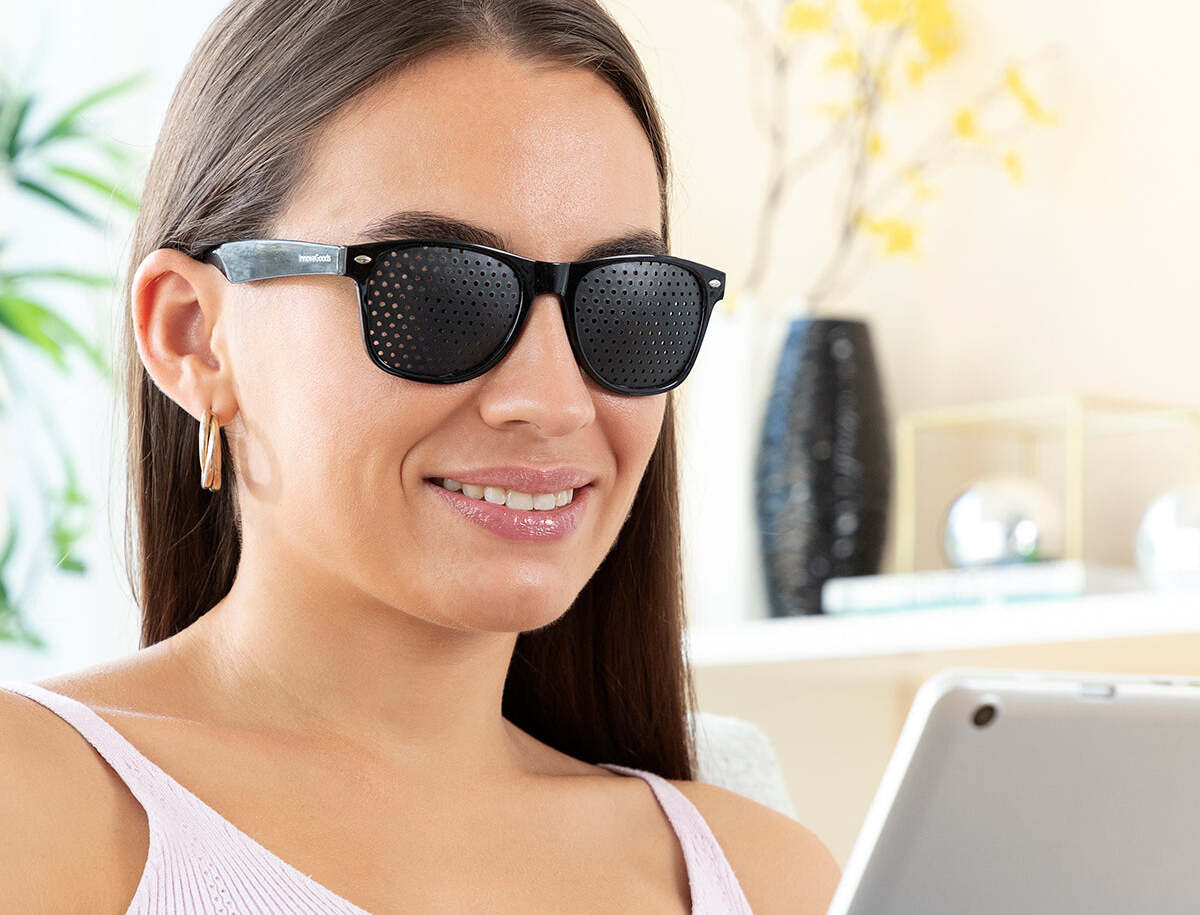It is believed that perforated glasses, also known as glasses with holes in everyday life, can solve some vision problems, in particular, cure myopia. We decided to check whether this opinion is justified.
Glasses with holes advertised on a set resourcesdedicated to vision. Their advise used for myopia (myopia), astigmatism, farsightedness, presbyopia, retinal degeneration and even cataracts. Some Russian manufacturers indicatethat their product is approved by the Ministry of Health of the Russian Federation. Training glasses are also recommended by the media: for example, in 2002 in the newspaper Trud came out article entitled “Get Your Sight Back?” Its author reported that “famous scientists gave reviews of the training glasses, and 12 research institutes and leading ophthalmological clinics recommended [the] Super-Vision [model] for production.” IN Internet Can meet many reviews, authors which claim that returned your vision thanks to these glasses.
Typically, perforated glasses are a plastic or metal frame into which, instead of classic lenses, plastic plates with many round holes arranged in a certain order are inserted. These glasses work on the principle pinhole cameras — looking through a narrow hole allows you to reduce the scattering spot on the retina, thereby increasing the clarity and sharpness of the image. Also, their operating principle can be compared to how we squint to see something better. Manufacturers such glasses explain: vision should improve because without glasses the eye is “lazy” and does not load the ciliary muscle - it is responsible for accommodation, that is, adapting the eye to different conditions. It is the training of the ciliary muscle that should supposedly help overcome myopia and other visual impairments.
However, recent scientific research showthat the main cause of myopia is genetic. So, if one of the parents is diagnosed with myopia, then with a 25% probability it will appear and the child. If both parents are myopic, the risk of developing pathology in the child increases to 50%. It is logical that it will not be possible to change genetic predisposition only by training the eye muscles. Experts from the reputable Cleveland Clinic (USA) list methods for correcting myopia: glasses, lenses, including orthokeratological or night lenses, laser surgeries, implantation of phakic intraocular lenses and eye gymnastics if myopia is caused by spasms. There are no perforated glasses among the products that have proven their effectiveness. Neither the National service UK health care, nor American association optometrists, nor the Federal Scientific and Clinical Center of the Federal Medical and Biological Agency (FSCC FMBA Russia).
It's a similar story with astigmatism - distortion of the refraction of light in the eye due to stretching of the cornea or lens into an irregular oblong shape. Due to the presence of holes in special glasses, this pathology cannot be cured by muscle training. Today doctors offer Such patients need to correct their vision using regular glasses and contact lenses or change the curvature of the cornea surgically.
Perforation glasses do not help with presbyopia - age-related refractive error of the eye, in which accommodation is impaired. Scientists agree that presbyopia is a natural process of aging, along with the appearance of gray hair and wrinkles, just as the lens loses its elasticity over time. Glasses with holes, of course, cannot turn back time and make your eyes look younger. Presbyopia is treated mainly surgically - with laser correction or lens replacement. Also in 2021 in the US came out The first eye drops capable of combating this pathology are on the market. The main active ingredient of the drug is a cholinergic muscarinic agonist, activating muscarinic receptors located on smooth muscles, such as the circular muscle of the iris (pupillary sphincter) and ciliary muscle.
At cataract - cloudiness lens due to protein denaturation - glasses advertised on the Internet will also not help, since they do not affect the cause of the disorder. Cataracts can only be treated surgically with implantation of an intraocular lens.
Thus, punch glasses do not help with any of the stated visual impairments simply because they do not affect the cause of the impairment. And although such glasses are sold in many countries, in 1993 the US Federal Trade Commission banned advertising of perforated glasses as a way to improve vision, since they did not give the declared effect. The commission's experts concluded that use of the device does not lead to long-term vision improvement, does not treat or correct specific vision problems, is not an adequate replacement for prescription contact lenses and glasses, and the recommended exercise program with it does not strengthen the eye muscles or improve vision.
But can such glasses be useful in that they protect against vision problems in the future? Korean scientists tried to find the answer to this question. In 2014 they held quantitative analysis of functional changes caused by wearing perforation glasses. The researchers did not obtain a clear positive result. When wearing pinhole glasses, participants had improved visual acuity, depth of field, and accommodative amplitude, but decreased quality of vision, contrast sensitivity, and stereopsis—the subjective sense of depth in space—as well as narrowed visual fields. Scientists have not recorded any long-term effects.
In 2017 the same team researched, how useful it is to read with pinhole glasses. To do this, the scientists invited 36 volunteers who were asked to undergo a series of medical measurements of visual acuity and read the text of a Korean folk tale, first without any glasses, then with perforation glasses, and finally with glasses with one narrow hole on each of the two plates (such a device, according to the manufacturers, also improves vision). After each stage of the experiment, participants assessed their condition according to seven parameters: eye fatigue, feeling of tension, burning sensation, discomfort in the eyes, difficulty focusing, difficulty concentrating, blurred vision and double vision. It turned out that both types of glasses improved ocular accommodation in the short term, but at the same time significantly reduced reading speed and caused symptoms of severe ocular discomfort.
2021 Review fails Bottom line: glasses with holes cannot improve vision in those who suffer from myopia, presbyopia and astigmatism, and will not serve to prevent such diseases. For a short time, when a person with a visual impairment wears such glasses, they can provide a clearer image, but simply squinting the eyes will have the same effect. However, one should not call perforation glasses useless - they are appropriate in an ophthalmologist’s office, as they help a specialist diagnose various diseases.
Thus, manufacturers' claims about miraculous glasses with holes do not correspond to scientific data. Perforated glasses will not relieve many common vision problems, since they do not address the cause of the disease. You can't expect long-term changes in the eye from wearing such glasses either. When reading, glasses with holes improve some vision indicators and worsen others, so they cannot be considered a complete prevention of visual fatigue. Instead of perforation glasses to relieve eye strain, doctors recommend adhere to the “20-20-20 rule” - every 20 minutes of work you need to take a break and for 20 seconds look at an object located 20 feet away (about 6 m).
Cover image: Pinhole Glasses Easview
Not true
If you find a spelling or grammatical error, please let us know by highlighting the error text and clicking Ctrl+Enter.






